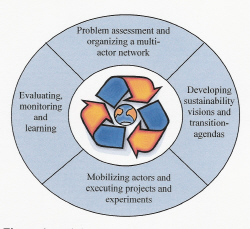Transition management (TM)
Use for
Instituting, promoting or steering a long-term social transformation process.
Principles
Transition management is inspired by complexity theory. Other important principles behind this method are that: 1) transitions or system innovations require changes at different levels of society; 2) innovation is driven mainly by front runners inside and outside the regime; 3) change is brought about by stakeholders formulating a common definition of the problem and a long-term vision; and 4) the fundamental uncertainty of transitions due to complex processes and discontinuities calls for a process of learning by doing and doing by learning.
What do you do?
The transition management cycle comprises the following elements (whose weight may differ from one round to another):

(i) structuring of the problem and creation of a vision in a participatory process and the organisation of a transition arena
(ii) development of a transition agenda, transition paths and experiments with broader coalitions and networks
(iii) planning and execution of transition experiments and mobilisation of existing transition networks
(iv) monitoring, evaluating and learning from transition experiments, using the conclusions to adjust the vision, agenda and coalitions.
NB: the suggestion in the figure that the steps in the transition management cycle occur successively is deceptive. In practice, some activities occur sequentially, some take place separately but simultaneously and some overlap.
Prerequisites
Applying transition management requires knowledge of the theory and methods of transition management. Transition competences are also important. On that point, see the cluster ‘Use of competences'.
More information
- Transition Management in the Urban Context: Guidance Manual.
- Loorbach, D. (2008). Why and how transition management emerges. Paper for the International Conference of the Socio- Ecological Research Programme, 22-23 Febr, Berlin, Germany.
- Loorbach, D. and J. Rotmans (2010). Article: The practice of transition management: Examples and lessons from four distinct cases. Futures 42, pp.237-246
- See also http://www.themusicproject.eu/content/transitionmanagement
Used by
Among others: Derk Loorbach, Drift, Erasmus University: Loorbach@drfit.eur.nl
